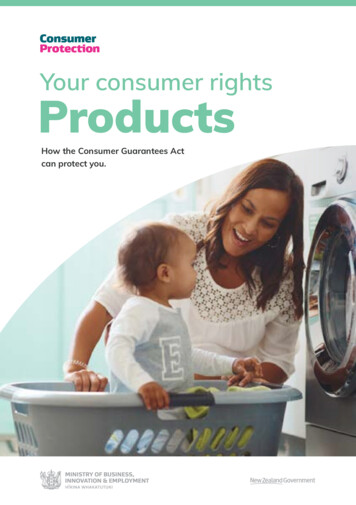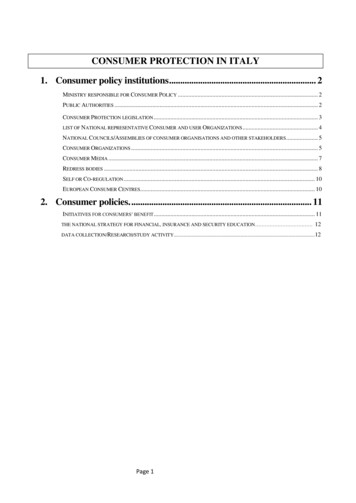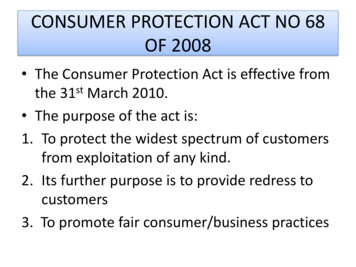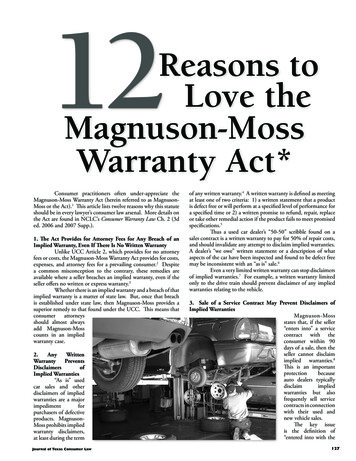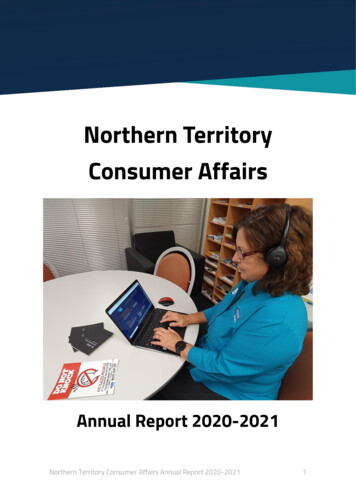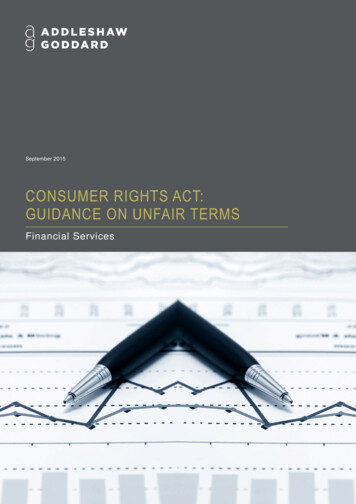
Transcription
September 2015CONSUMER RIGHTS ACT:GUIDANCE ON UNFAIR TERMSFinancial Services
CONSUMER RIGHTS ACT:GUIDANCE ON UNFAIR TERMSThe Consumer Rights Act 2015 comes into force on 1 October 2015 in respect ofupdated consumer rights and protection from unfair terms. The Competition andMarkets Authority's guidance on the unfair terms provisions in the Act, which waspublished on 31 July 2015, sets out its understanding of their effect, as well asproviding detailed suggestions about how consumer contracts can be drafted tocomply with the law.BackgroundPart 1 of the Consumer Rights Act 2015 (CRA) updates and modernises consumer rights in contracts for goods, digitalcontent and services. Part 2 of the CRA will replace the Unfair Terms in Consumer Contracts Regulations 1999 (UTCCRs), inits entirety, and the Unfair Contract Terms Act 1977 (UCTA) in so far as it affects consumer contracts. UK legislation on unfairterms law will, therefore, be updated and consolidated in one place.The Competition & Markets Authority (CMA) is the UK's national competition and consumer authority, having replaced theOffice for Fair Trading (OFT) and is responsible for enforcing this legislation. When referring to the CMA's guidance, it isimportant to remember that as well as considering the meaning of the CRA, it draws on the CMA's understanding of how theEU Court of Justice has interpreted the EU Directive on Unfair Contract Terms which national legislation implements. Therehave been a number of decisions in recent years on, for example, variation clauses, where consideration has been given towhat the fairness test requires in practice.The guidance replaces that previously issued by the OFT (OFT311) in 2001, which was adopted by the CMA in 2014 and itspurpose is to set out the CMA's understanding of the CRA. The changes in this legislation are mainly in scope rather thansubstance and must be understood and interpreted in the light of both UK and European Union case law. The guidance isaimed, primarily, at in-house advisers and trade associations for businesses. Additionally, it is intended to assist publicauthority regulators, in particular, Trading Standards Services which has published separate guidance on its " BusinessCompanion" website on the statutory rights and remedies enjoyed by consumers under the CRA.Alongside the guidance, historic guidance on unfair terms first published by the OFT in September 2008 has been madeavailable, which has been republished as "Annex A".FCA Unfair Terms Contract Guidance & LibraryEarly in 2015, the Financial Conduct Authority (FCA) withdrew the majority of its sector specific guidance to financial servicesfirms. This was on the basis that it no longer adequately reflected the case law of the EU Court of Justice, which has adoptedan activist consumer stance, and that it required review in anticipation of the coming into force of the CRA and the CMA'sguidance. The FCA material included undertakings given by firms in relation to the use of specific terms and, while stillbinding on relevant firms, they no longer reflect the FCA's view on unfair terms. Given the necessarily generic nature of theCMA's guidance it is hoped that updated financial services specific guidance will be provided in early course. As of now theFCA has not done so.Applicability of the Consumer Rights ActThe CMA guidance confirms that the CRA has prospective effect from 1 October 2015, superseding the UTCCRs, and inrespect of consumer contracts, the UCTA. As stated, the changes in respect of the law on unfair terms are best characterisedas mainly consisting of changes in scope rather substance. In this regard, the CRA and the guidance seek to reflectdevelopments in both UK, but also in EU case law. While the UTCCRs and the UCTA will still apply to contracts entered intobefore 1 October 2015, in so far as the substance of the law is concerned, businesses would be best placed not to distinguishbetween the legislation.10-5599813-31
Unfair Terms & CMA GuidanceThe Fairness TestAs discussed, the general rules about fairness are unchanged. A term will be unfair if, contrary to the requirements of goodfaith, it causes a significant imbalance in the parties' rights and obligations to the detriment of the consumer. Whether a termis fair is determined by taking into account the nature of the subject matter of the contract and by reference to all thecircumstances existing when the term was agreed, and to all the other terms of the contract, or any other contract on which itdepends.In its guidance, the CMA explains that a significant imbalance cannot be avoided just by ensuring that there is a mechanical orformal equivalence in rights and obligations. While an imbalance must be practically significant, it is not limited to purelyfinancial considerations. Moreover, a finding of unfairness does not require proof that a term has caused actual harm, ratherthat it could potentially cause consumer detriment.The requirement of good faith, according to the CMA, entails a general principle of "fair and open dealing". Contracts shouldbe drawn up to respect the legitimate interests of consumers and the CMA goes as far as to refer to "good standards ofcommercial morality and practice". Referring to the decision in The Office of Fair Trading v Foxtons [2009] EWHC 1681 (Ch),the guidance restates the words of Lord Bingham, that a trader "should not, whether deliberately or unconsciously, takeadvantage of the consumers' circumstances to their detriment". In this context, the CMA refers to economic research abouthow consumers behave in practice where they do not always read (or it is impractical to do so) the terms of all contracts theyenter into.Consumer vulnerabilityEarly this year, the FCA published an Occasional Paper on consumer vulnerability. This aims to broaden understanding andstimulate interest and debate around vulnerability, while providing practical help to firms in developing and implementing avulnerability strategy. In this context, firms should take note that the guidance refers to the need to take particular care incommunicating key terms to consumers who might have "greater difficulty than others in collecting, processing and actingupon information and thus in exercising choice effectively". Consumers may also be vulnerable when making infrequent orexpensive purchases – a scenario relevant to some financial services sectors.Core exemptionA term may not be assessed for fairness to the extent that it concerns the main subject matter of the contract or theappropriateness of the price (the core exemption), providing it is transparent and prominent (the latter requirement is new andrepresents a significant change from the UTCCRs – see below) and is not on the Grey List.The guidance refers to the judgment of the EU Court of Justice in Árpád Kásler v OTP Jelzálogbank Zrt. Case C-26/13 whichdescribed those terms falling into the core exemption as the "very essence of the contractual relationship". Where a termimposes a payment or charge, then a service, goods or digital content must be provided in return. In the EU Court of Justice,in Case C-472/10: Nemzeti Fogyasztóvédelmi Hatóság v Invitel Távközlési Zrt , terms providing for variation of such chargeswere said not to be core terms and could be assessed for fairness. Moreover, the core exemption in the view of the CMA mustbe interpreted narrowly and is not there to circumvent the requirement of fairness.Grey ListThe Grey List is an indicative and non-exhaustive list of terms that may be potentially regarded as unfair. While the Grey Listcontains exceptions, some of which are relevant to financial services, the CMA considers that the list is not to be interpretedwidely, nor that the carve outs provide exemptions from the requirement of fairness. The CRA largely leaves the Grey List as itwas under the UTCCRs but has added three new items concerning disproportionate termination fees, rights to determine orchange what is supplied and price variation clauses. A price variation clause is particularly relevant to long term or indefiniteperiod contracts in financial services. The CMA guidance explains that, while such clauses are not necessarily unfair becausethey are discretionary, they must be clear as to what consumers can expect and not be open to abuse. Reference is made tothe judgment of the EU Court of Justice in RWE Vertrieb AG v Verbraucherzentrale Nordrhein-Westfalen e.V ., C-92/11 (21March 2013).Terms in the Grey List may, for example, involve a trader arbitrarily varying the terms after the contract has been made, orraising the price. Such instances commonly occur in financial services in terms and conditions for payment accounts, creditcards and mortgage products. In this regard, in July 2014, the FCA published a discussion paper, DP14/2, setting out how itassesses the fairness of changes made by lenders to regulated mortgage contracts. In addition to firms' obligations underunfair terms law, the FCA will consider whether the change satisfies the Principles for Businesses (PRIN) 6 – a firm must paydue regard to the interests of its customers and treat them fairly - and 7 – a firm must pay due regard to the information needsof its clients and communicate information to them in a way which is clear, fair and not misleading - and other rulebook10-5599813-32
requirements (e.g. MCOB). It will consider the reasons for making the change, a customer's reasonable expectations, whatcustomers were told about the product features and the affect on customers of the change.TransparencyThe CRA requires that a written term of a consumer contract or a consumer notice is transparent. A term which is nottransparent cannot benefit from the core exemption, but is otherwise not automatically treated as unfair. Rather, in line withnormal rules of construction, where there is ambiguity it will give the most favourable interpretation to the consumer.A term fulfils the requirement of transparency, if it is expressed in plain and intelligible language and it is legible. The guidancestates that transparency is "fundamental to fairness in a general sense". The EU Court in Nemzeti Fogyasztóvédelmi Hatóságv Invitel Távközlési Zrt, held that in a consumer contract where the supplier may unilaterally vary fees, and statute orregulation gives the consumer a right to terminate if the supplier does so, the supplier must state this right in the contract inplain and intelligible language. However, going beyond the language of the Act and drawing on the decision of the EU Court ofJustice in RWE Vertrieb AG v Verbraucherzentrale Nordrhein-Westfalen e.V ., the CMA considers that legibility and clarity oflanguage are not enough; rather, terms should be drafted to ensure that consumers can make informed choices. In thecontext of a term purporting to allow a firm to vary the price unilaterally, the Court asked "whether the contract [set] out intransparent fashion the reason for and method of the variation of those charges, so that the consumer [could] foresee, on thebasis of clear, intelligible criteria, the alterations that may be made to those charges". This language is not too far removedfrom the FCA's treating customers fairly approach. Expanding on this theme, in Árpád Kásler v OTP Jelzálogbank Zrt., the EUCourt said that "plain and intelligible" meant that the "consumer is in a position to evaluate, on the basis of clear, intelligiblecriteria, the economic consequences for him which derive from it". The CMA suggest that firms may seek to make significantterms more transparent by providing explanatory material, for example, a summary or a "cooling-off" period. It goes withoutsaying that a disadvantageous term should not be hidden.ProminenceUnlike "transparency", which derives from the Directive, "prominence" is a UK concept included in national legislation for thefirst time. The CRA provides that a term is prominent if it is brought to the consumer's attention in such a way that the averageconsumer would be aware of it. The guidance states that, in the CMA's view, consumers cannot generally be expected to readthoroughly the small print of standard contracts. Therefore, suitable prominence ought to be given to terms depending on theirimportance and, where necessary, critical terms highlighted. The guidance accepts that it may not always be possible to givea large number of terms suitable prominence and that this might mean, in certain cases, that businesses cannot now benefitfrom the core exemption to the extent they would wish. While the addition of this requirement may appear to represent asignificant departure, in reality the CRA and the guidance are reflecting recent case law.Smarter Consumer CommunicationsWhen considering the requirements of transparency and prominence, firms also need to consider their inter-relationship withother regulatory initiatives. In June 2015, the FCA published a discussion paper on Smarter Consumer Communications,DP15/5, and is encouraging firms and other stakeholders to work together to deliver information to consumers in moreeffective ways. The publication explains that the FCA wishes to start a debate and identifies a number of areas which couldbenefit from a new approach. These include firms' terms and conditions which the FCA says are too legalistic and lengthy.The regulator will also look at its own rules and requirements in a Handbook review and, where permitted by EU legislation,will seek to remove unnecessary provisions. In doing so it will consider the extent to which disclosure requirements haveactually helped customers make informed decisions about their money.EXAMPLES IN BRIEFCRA REQUIREMENTISSUEPOTENTIAL MITIGATION BY FIRMSFairness Test element 1 –Significant Imbalance Is the term/notice weighted in Redress balance in contract – equalfavour of the business?footing Ensure both parties to the contracthave rights of equal extent andvalue in reality A significant imbalance cannot beavoided just by ensuring a merelymechanical or formal equivalence10-5599813-33 Redress balance - appropriate toeach party's circumstances (i.e. samesanctions cannot apply to both traderand consumer). Think through eachparty's position and consumer'slegitimate interests
EXAMPLES IN BRIEFCRA REQUIREMENTISSUEPOTENTIAL MITIGATION BY FIRMSin rights and obligations. Termscannot alter the balance in rightsand obligations that the law wouldhave struck if left to itself Do not necessarily mirror rights andobligations of the parties but tailor tothe circumstances of each. Terms cannot restrict legal rightsand resort to the courts Terms cannot impose additionalobligations or risks not envisagedby law or that unreasonably gobeyond what is expected.Fairness Test element 2 –Good Faith Terms /notices must not to takeadvantage of the consumers'circumstances to their detriment Dealing with concerns aroundtermination and renewal fees If trader's representative is presentwhen a contract is entered into,consumer vulnerability will need tobe considered in all cases.Transparency – a lack oftransparency will not render aterm or a noticeunenforceable but ambiguitywill be interpreted in favour ofthe consumer Plain and intelligible language Legibility of written terms Consumer must be able to evaluatethe economic consequences of acontract Liability cannot simply be excluded"to the extent permitted by law/statute" A consumer must be aware of theterm or notice. Openness – ensure appropriateprominence is given todisadvantageous terms In formulating contract terms/notices –firms should take the legitimateinterests of the consumer intoaccount. Terms should be drafted to ensureconsumers can make informedchoices. Disadvantageous terms mustbe given appropriate prominence.Consider using: Ordinary words Restricted not vague words Short sentences Sub-headings No statutory references No elaborate definitions Avoid extensive cross-referencing Consider providing a "cooling-off"period (including a cancellation right).10-5599813-34
Key Changes Reflected in GuidanceGenerally speaking, the scope, rather than the substance of the law, on unfair terms has changed and this is reflected in theCMA's guidance:Consumer notices In addition to consumer contracts, consumer notices are brought unequivocally within the fairness regime. A consumernotice is any notice to the extent that it relates to rights or obligations as between a trader and a consumer or purports toexclude or restrict a trader's liability to a consumer. A notice is said to include an announcement (whether or not in writing),and any other communication or purported communication, which does not have to be expressed to apply to a consumer,so long as it is reasonable to assume it is intended to be read by a consumer. This extends the scope of the fairnessregime to non-contractual communications. The CMA considers that that consumer notice provisions in the CRA areparticularly important in the context of transactions involving digital content. Software and other digital products are sold toconsumers subject to End User Licence Agreements (EULAs). For legal purposes, the terms of the EULAs may not, in allcases, be clearly part of the contract with the consumer. But if they are not, they are very likely to be covered by the CRA'sunfair terms provisions as consumer notices.Individually negotiated contracts A significant change in the CRA from the UTCCRs is the application (for the first time) of the fairness test to individuallynegotiated contracts and not just standard form contracts. The CMA guidance nonetheless considers that the contentionthat customer has influenced the substance of the terms needs to be treated with caution and tested against a detailedconsideration of the circumstances surrounding the entering into of the contract.The Core Exemption In order for a term to benefit from the core exemption from the fairness test it must now satisfy not only the requirement oftransparency, but that of "prominence" as well as being legible, if in written form. The guidance provides a flow chart whichhelps to determine if the exemption applies in various given scenarios. The core exemption does not apply to consumernotices because this concept is limited to core contractual terms or, as described by the EU Court of Justice, as thoseforming "the essence of the contractual relationship".Services & digital content Part 1 of the CRA extends the law relating to and clarifies consumer rights to digital content. To the extent that a termpurports to exclude or restrict a statutory right, for example, that digital content is to be of satisfactory quality, it will be notbe binding (i.e. blacklisted).Amendments to the Grey List As discussed above, there are three additions to the Grey List concerning: 1) disproportionate termination fees andrequiring consumers to pay for services not supplied, 2) rights to determine or change what is supplied, and 3) pricevariation clauses.The average consumer Reflecting the CRA and EU case law, guidance is given as to who the "average consumer" is (this being an objective test),who is described as "a consumer who is reasonably well informed and observant and circumspect". Reference is alsomade in the guidance to "awareness". This is taken to denote awareness for practical purposes. The CMA considers thatbusinesses, when formulating their terms and sales processes, need to focus on ensuring consumers are in a position tomake informed purchasing decisions. The guidance also makes clear that in assessing fairness the circumstances existingwhen the term was agreed must be examined. In this respect, the guidance now includes an explanation of behavioural economics and how the average customerbehaves in practice. This reflects an important change in the approach of UK regulators which have moved beyondreliance on simple disclosure as a means of consumer protection. A further issue is the relationship between the averagecustomer and the requirement on firms with respect to treating vulnerable customers appropriately. The FCA's OccasionalPaper on consumer vulnerability provides a very wide definition of "someone who, due to their personal circumstances, isespecially susceptible to detriment." and where many customers can, potentially, during a product lifecycle, beconsidered vulnerable. Firms needs to give careful consideration this issue.10-5599813-35
Secondary contracts As a tool to prevent evasion, the scope of the fairness regime is extended to terms in secondary contracts which reducerights or remedies or increase the obligations of consumers under a consumer contract. This provision extends the scopeof protection to contracts agreed in addition to the original consumer contract, whether made before, after or in addition toit. The secondary contract does not need to be a consumer contract and it could be a contract between different parties.Annex A ExamplesAnnex A complements the CMA guidance providing examples of terms which are regarded as unfair and suggests ways inwhich firms can satisfy the fairness test. Originally prepared as an annex to the OFT's guidance on unfair terms, it has beenrepublished as an annex to the CMA's guidance because it is considered capable of illustrating the practical impact of thefairness provisions in the CRA (in particular the Grey List) which remain substantially the same as drafted previously. It must,however, be read in conjunction with the main text of the CMA guidance and does not necessarily reflect that authority's view.We include a few examples from this annex by way of illustration.Example 1 – CMA Approach to Statutory ReferencesOriginal TermThe Insurers shall not be liable for claims directly or indirectly arising from Financial circumstances or employment otherthan redundancy (where the Insured Person qualifies for payment under the Redundancy Payments Legislation).New termThe Insurers shall not be liable for claims directly or indirectly arising from your financial circumstances or employmentother than redundancy (if you qualify for payment under the Redundancy Payment legislation, that is, you are under 65 andhave 2 years' continuous employment).- Page 93, Annex A, CMA Guidance on unfair terms provisions in the Consumer Right Act, 31 July 2015Example 2 – CMA Approach to Financial PenaltiesOriginal termIn the event of legal action for breach of payment, the customer shall be responsible for all costs and disbursementsincurred by A&S on a full indemnity basis.New termIn the event of legal action for breach of payment, the customer shall be responsible for all costs allowable by the courtsif an award is made in A&S's favour.- Page 39, Annex A, CMA Guidance on unfair terms provisions in the Consumer Right Act, 31 July 2015Example 3 – CMA Approach to Binding Customers to Hidden TermsOriginal termAll orders shall be subject to these Conditions. The acceptance by the Seller of any order shall be deemed to incorporatethese Conditions.New termAll orders are subject to these conditions. If this is not acceptable the Seller should be contacted within 7 days and a fullrefund will be given for unopened and unused goods.- Page 53, Annex A, CMA Guidance on unfair terms provisions in the Consumer Right Act, 31 July 2015Impact on FCA rulesThe FCA has powers under the current UTCCRs to challenge unfair terms in standard form consumer contracts entered intoby firms that undertake regulated activity. The CMA is the principal enforcer of the UTCCRs and will keep that role under theCRA. To reflect the introduction of the CRA, the FCA in its consultation paper, CP15/19, proposes to make changes to its10-5599813-36
Unfair Contract Terms Regulatory Guide (UNFCOG) which sets out how it uses its powers under the UTCCRs, for example, toobtain undertakings and seek information from firms. The amendments reflect those matters highlighted in the CMA guidance,such as the removal of all UTCCR references and the inclusion of "consumer notices" to sit alongside contract terms. Otherparts of the FCA Handbook will also be updated, for instance, to reflect the new wider definition of "consumer". Thesechanges will most notably be seen across the Conduct of Business Sourcebook (COBS), the Mortgage and Home Finance:Conduct of Business Sourcebook (MCOB) and the Consumer Credit Sourcebook (CONC).Under Schedule 3 of the CRA, the FCA will be afforded equivalent enforcement powers to enable it to apply for injunctions inrelation to contract terms and notices that are unfair. The FCA's investigatory powers will, however, be widened underSchedule 5 and Part 8 of the Enterprise Act 2002. The Enforcement Guide will be updated to reflect the position and anupdated version of the Memorandum of Understanding between the FCA and CMA will be released in due course.As referred to above, the FCA has yet to issue revised and updated guidance over how it expects the financial services sectorto comply with the unfair terms regime in the CRA and reflecting developments in case law.How may financial services firms be affected?The CMA's guidance will help businesses understand what makes terms and notices unfair and how to address these. Theguidance identifies key steps that businesses should take to ensure that they communicate clearly with consumers and avoiddisputes arising from unfair terms. Alongside specific advice such as avoiding using legal jargon in contracts, the guidanceurges businesses to deal "openly and fairly" with consumers and not to use terms that you "would not like to sign up toyourself".Less positively, the guidance adopts an activist consumer stance in its approach to fairness and good sense with itsreferences to "morality" and its demanding standards in respect of transparency and prominence. Furthermore, given itsgeneric nature, the realities of the financial services sector are not always adequately recognised. It is to be hoped that theFCA will publish new guidance in the near future.The updating and strengthening of the consumer rights and unfair terms law should be seen by firms as one, but a verysignificant, regulatory development that requires a consistent and complementary response.Key Take-aways Review existing literature, terms & conditions and notices to ensure they are fair and transparent to the average consumer Train compliance and customer dealing staff on the requirements of the legislation and guidance Refer to the guidance and Annex A for real-life examples of unfair terms and how these can be mitigated Take note of the FCA's new enforcement powers and civil remedies Review customer journey and take holistic approach to communicating information to clients.How can Addleshaw Goddard help?Addleshaw Goddard’s consumer and financial services specialists can advise you on your client documentation together withsystems and controls to ensure compliance with legal and regulatory obligations. We can undertake to complete a review ofyour current terms and conditions, from an unfair terms perspective, together with a review of your customer journey. We havea wealth of experience in conducting regulatory reviews of business functions so as to provide senior management thecomfort that there are compliant systems and controls in place. Our approach is forensic, applying the minimum necessaryresource required to provide you with appropriate assurance. However, where needed, we have access to a dedicated pool ofover 100 specialist paralegals in our Transaction Support Team.The product of our reviews is legally privileged, which is an essential protection against third party disclosure, and anadvantage that can only be afforded by law firms.10-5599813-37
To discuss anything in this briefing, please contact Rosanna Bryant or any of the team contacts below.CONTACTSAmanda HulmePartner, Head of FinancialRegulation Team020 7880 585307921 404515Sophie CochraneAssociate020 7160 393907912 395667Rosanna BryantPartner0113 209 204807738 69749Toby DavisAssociate020 7160 333807809 594022Niki WordenPartner020 7160 302307730 193330Richard PowellProfessional Support Lawyer020 7160 319507711 468143Harriet MilburnManaging Associate0113 209 493607738 023417Jennifer IrvingManaging Associate0113 209 767707872 548545James TurnerManaging Associate0207 160 320807894 251328Jenny GuestAssociate0113 209 2494Charlotte HarrisonManaging Associate0207 160 344307921 492934To email: 1
addleshawgoddard.comDoha, Dubai, Hong Kong, Leeds, London, Manchester, Muscat, Singapore and Tokyo**a formal alliance with Hashidate Law Office 2015 Addleshaw Goddard LLP. All rights reserved. Extracts may be copied with prior permission and provided their source is acknowledged.This document is for general information only. It is not legal advice and should not be acted or relied on as being so, accordingly Addleshaw Goddard disclaims any responsibility. Itdoes not create a solicitor-client relationship between Addleshaw Goddard and any other person. Legal advice should be taken before applying any information in this document to anyfacts and circumstances.Addleshaw Goddard is an international legal practice carried on by Addleshaw Goddard LLP (a limited liability partnership registered in England & Wales and authorised a nd regulated bythe Solicitors Regulation Authority) and its affiliated undertakings. Addleshaw Goddard operates in the Dubai International Financial Centre through Addleshaw Goddard (Middle East)LLP (registered with and regulated by the DFSA), in the Qatar Financial Centre through Addleshaw Goddard (GCC) LLP (licensed by the QFCA), in Oman through Addleshaw Goddard(Middle East) LLP in association with Nasser Al Habsi & Saif Al Mamari Law Firm (licensed by the Oman Ministry of Justice) and in Hong Kong through Addleshaw Goddard (Hong Kong)LLP (a limited liability partnership registered in England & Wales and registered and regulated as a foreign law firm by the Law Society of Hong Kong) in associatio
CMA's guidance it is hoped that updated financial services specific guidance will be provided in early course. As of now the FCA has not done so. Applicability of the Consumer Rights Act The CMA guidance confirms that the CRA has prospective effect from 1 October 2015, superseding the UTCCRs, and in respect of consumer contracts, the UCTA.


